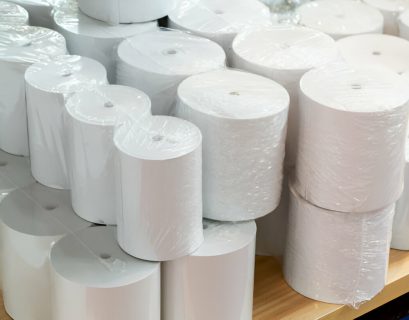Thermal roll paper might not be a flashy topic, but it’s a crucial component in many industries. From retail stores to restaurants, gas stations to medical facilities, businesses everywhere rely on it for receipts, invoices, and other printed materials.
Choosing the right thermal roll paper can impact your business efficiency, customer satisfaction, and even your budget. Whether you’re new to this product or looking to optimize your use of it, this guide will walk you through everything you need to know—covering its uses, benefits, and what to watch out for when selecting the perfect rolls for your business.
What Is Thermal Roll Paper?
Thermal roll paper is a specially coated paper that reacts to heat to create printed text or images without requiring traditional ink or toner. This heat sensitivity makes it ideal for thermal printers, which are commonly used in business environments where fast, reliable printing is essential.
A thermal printer uses a heated printhead to activate the coating on the paper, quickly producing clear, sharp prints. These printers are often favored for their speed, quiet operation, and lack of ink cartridge requirements.
Industries That Use Thermal Roll Paper
Thermal roll paper is used across a wide range of industries, including:
- Retail: Cash registers and point-of-sale (POS) systems rely on thermal rolls for fast and efficient receipt printing.
- Hospitality: Restaurants and cafes use thermal paper for receipts and kitchen order tickets.
- Transportation: Gas stations, toll booths, and parking systems operate efficiently with thermal rolls for tickets and invoices.
- Healthcare: Clinics and hospitals often employ thermal paper for patient receipts, billing, and even medical devices like ECG machines.
By understanding its versatility, you can better appreciate why selecting the right paper matters.
Benefits of Using Thermal Roll Paper
If you’re wondering why thermal roll paper is so widely used, here are some key benefits that set it apart from other options.
1. Cost-Effective
Unlike traditional printing that requires ink or toner, thermal printing cuts costs by eliminating the need for cartridges. Over time, this translates into significant savings, especially for businesses with high printing volumes.
2. Fast and Reliable
Thermal printers are designed to handle high-speed printing with minimal downtime. Whether you’re printing dozens of receipts in a retail environment or generating patient invoices in a clinic, efficiency is key—and thermal roll paper delivers.
3. High Print Quality
The heat-sensitive coating on thermal roll paper ensures crisp, legible prints. This is especially important when printing details like barcodes, logos, or fine text.
4. Low Maintenance
Thermal printers, and by extension their paper, require less maintenance. Fewer moving parts and no ink spills make them a hassle-free choice.
5. Environmentally Friendly Options
Some thermal roll papers are available in eco-friendly variations, such as BPA-free or recyclable options. These cater to businesses aiming for sustainability without compromising performance.
How to Choose the Right Thermal Roll Paper
Not all thermal roll paper is created equal. Choosing the right one for your business involves evaluating several factors, such as printer compatibility, size, and environmental considerations.
1. Check Compatibility with Your Printer
First and foremost, ensure the thermal rolls are compatible with your thermal printer model. Check the printer’s manual for the required roll width and length. Using the wrong size could damage your printer or result in poor printing performance.
2. Consider the Paper Quality
Look for thermal roll paper with durable and high-quality coatings. This ensures that prints remain clear and legible, even under challenging storage conditions like heat or humidity.
3. Evaluate BPA-Free Options
Many thermal papers are manufactured with BPA (Bisphenol A), a chemical that has raised health concerns. If your business uses thermal paper extensively or interacts with customers frequently, consider switching to BPA-free options.
4. Choose the Right Size
The dimensions of your thermal roll paper need to match your printer. Common sizes include 2 1/4 inches or 3 1/8 inches in width. Additionally, check the roll length to match your printing volume needs.
5. Look for Long-Lasting Prints
If you need receipts or records to last for years, opt for thermal papers with enhanced durability. Some papers are designed to resist fading, making them ideal for archiving purposes.
6. Assess the Cost and Supplier Reliability
While going for the cheapest option might seem appealing, it’s essential to balance affordability and quality. Only buy from trusted suppliers who can guarantee consistent quality and timely delivery.
Common Challenges and Tips to Overcome Them
Like any product, thermal roll paper comes with its own set of challenges. Here are a few common issues and how to address them effectively.
1. Fading Prints
Thermal printing can fade over time, especially when exposed to heat, light, or moisture. For important documents, consider storing them in cool, dark places or scanning digital copies as backups. You can also purchase fade-resistant thermal paper if longevity is a concern.
2. Printer Jams and Misfeeds
Using thermal rolls that are too wide or poorly manufactured could lead to printer jams. Always ensure you’re using the correct size and high-quality rolls to prevent performance issues.
3. Customer Misconceptions About BPA
While BPA concerns may arise, educating your customers on your efforts to use BPA-free or eco-friendly thermal paper can enhance your commitment to health and sustainability. Include this information on your receipts or packaging, if applicable.
Steps to Transition to Thermal Roll Paper
If you’re not already using thermal roll paper, here’s how to make a smooth transition for your business.
- Step 1: Assess your printing requirements, including volume and specific use cases (receipts, invoices, etc.).
- Step 2: Choose a reliable thermal printer and ensure it aligns with your existing systems and software.
- Step 3: Source high-quality thermal roll paper that suits your needs, ensuring it meets any eco-friendly standards you prioritize.
- Step 4: Train your team on how to load and maintain the thermal printer for maximum uptime.
Making this switch can improve workflow efficiency and reduce operational costs, so it’s worth exploring sooner rather than later.
Maximize Efficiency with the Right Thermal Paper
Thermal roll paper plays a silent but vital role in countless daily transactions. From making your customer experience frictionless to ensuring your back office runs smoothly, this innovation is a powerhouse for modern businesses.
To get the most out of thermal roll paper, invest in high-quality materials, educate your team about its proper use, and stay informed about the latest product developments. These small steps can make a big difference in keeping your operations seamless and professional.
Start your search for quality thermal roll paper today and watch your business efficiency take off!










